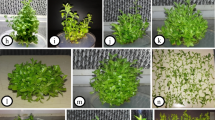Abstract
Different explant materials were treated with antimitotic agents to induce chromosome doubling in several Miscanthus sinensis clones. In vitro propagated plants established in soil, in vitro shoots, embryogenic callus, shoot apices and leaf explants were treated with different concentrations of colchicine or oryzalin. No tetraploids were obtained after antimitotic treatment of plants established in soil. The percentage of chromosome doubled plants after antimitotic treatment of single in vitro shoots was genotype dependent. Rooted in vitro plantlets were not a suitable target for antimitotic treatment, due to a high frequency of ploidy chimeras. Many tetraploid plants were regenerated after antimitotic treatment at the callus and explant level, but the efficiency was genotype dependent, primarily due to differences in the ability to form regenerable callus and to regenerate plants from embryogenic callus. Treatment of shoot apices with colchicine was the most efficient and reproducible system in the four genotypes tested. It was possible to repeatedly use the same colchicine-containing medium without any reduction in the induction of regenerable callus or in the percentage of tetraploids, thereby minimising the handling of this very toxic compound.
Similar content being viewed by others
References
Bajer AS & Molé-Bajer J (1986) Drugs with colchicine-like effects that specifically disassemble plant but not animal microtubules. Ann. NY Acad. Sci. 466: 767-784
Bassam El N, Dambroth M & Jacks I (1992) DeDie Nutzung von Miscanthus sinensis (Chinaschilf) als Energie-und Industriegrundstoff. Landbauforschung Völkenrode 42: 199-205
Beale CV & Long SP (1995) Can perennial C4 grasses attain high 4efficiencies of radiant energy conversion in cool climates? Plant Cell Environ. 18: 641-650
Chakraborti SP, Vijayan K, Roy BN & Qadri SMH (1998) In vitro induction of tetraploidy in mulberry (Morus alba L.). Plant Cell Rep. 17: 799-803
Holme IH & Petersen KK (1996) Callus induction and plant regeneration from different explant types of Miscanthus x ogiformis Honda ‘Giganteus’. Plant Cell Tiss. Org. Cult. 45: 43-52
Holme IH, Krogstrup P & Hansen J (1997) Embryogenic callus formation, growth and regeneration in callus and suspension cultures of Miscanthus x ogiformis Honda ‘Giganteus’ as affected by proline. Plant Cell Tiss. Org. Cult. 50: 203-210
Jørgensen U (1997) Genotypic variation in dry matter accumulation and content of N, K and Cl in Miscanthus in Denmark. Biomass Energy 12: 155-169
Linde-Laursen I (1993) Cytogenetic analysis of Miscanthus ‘Giganteus’, an interspecific hybrid. Hereditas 199: 297-300
Morejohn LC & Fosket DE (1984) Inhibition of plant microtubule polymerization in vitro by the phosphoric amide herbicide amiprophos-methyl. Science 224: 874-876
Morejohn LC, Bureau TE, Tocchi LP & Fosket DE (1984) Tubulins from different higher plant species are immunologically nonidentical and bind colchicine differentially. Proc. Natl. Acad. Sci. USA 81: 1440-1444
Morejohn LC, Bureau TE, Molé-Bajer J, Bajer AS & Fosket DE (1987) Oryzalin, a dinitroaniline herbicide, binds to plant tubulin and inhibits microtubule polymerization in vitro. Planta 172: 252-264
Murashige T & Skoog F (1962) A revised medium for rapid growth and bioassays with tobacco tissue cultures. Physiol. Plant. 15: 473-497
Nielsen JM, Brandt K & Hansen J (1993) Long-term effects of thidiazuron are intermediate between benzyladenine, kinetin or isopenenyladenine in Miscanthus sinensis. Plant Cell Tiss. Org. Cult. 35: 173-179
Petersen KK (1997) Callus induction and plant regeneration in Miscanthus x ogiformis Honda ‘Giganteus’ as influenced by benzyladenine. Plant Cell Tiss. Org. Cult. 49: 137-140
Petersen KK, Hagberg P & Kristiansen K (2002) In vitro chromosome doubling of Miscanthus sinensis. Plant Breeding 121: 445- 450
SAS Institute Inc. 1989. SAS/STAT* Users Guide, Version and Fourth Edition,Volume 2, SAS Institute Inc., Cary, NC, (pp. 846)
Schwarz von H, Liebhard P, Ehrendorfer K & Ruckenbauer P (1993) Ertragsverlauf von Miscanthus sinensis ‘Giganteus’ auf zwei Ackerstandorten in Österreich. Bodenkultur 44: 253-263
Tambong JT, Sapra VT & Garton S (1998) In vitro induction of tetraploids in colchicine-treated cocoyam plantlets. Eupytica 104: 191-197
Tu S-I, Patterson D, Brauer D & Hsu A-F (1995) Inhibition of corn root membrane ATPase activities by oryzalin. Plant Physiol. Biochem. 33: 141-148
Wan JF, Petolino JF & Widholm JM (1989) Efficient production of doubled haploid plants through colchicine treatment of anther-derived maize plants. Theor. Appl. Genet. 77: 889-892
Wan Y, Duncan DR, Rayburn AL, Petolino JF & Widholm JM (1991) The use of antimicrotubule herbicides for the production of doubled haploid plants from anther-derived maize callus. Theor. Appl. Genet. 81: 205-211
Author information
Authors and Affiliations
Corresponding author
Rights and permissions
About this article
Cite this article
Koefoed Petersen, K., Hagberg, P. & Kristiansen, K. Colchicine and oryzalin mediated chromosome doubling in different genotypes of Miscanthus sinensis . Plant Cell, Tissue and Organ Culture 73, 137–146 (2003). https://doi.org/10.1023/A:1022854303371
Issue Date:
DOI: https://doi.org/10.1023/A:1022854303371




